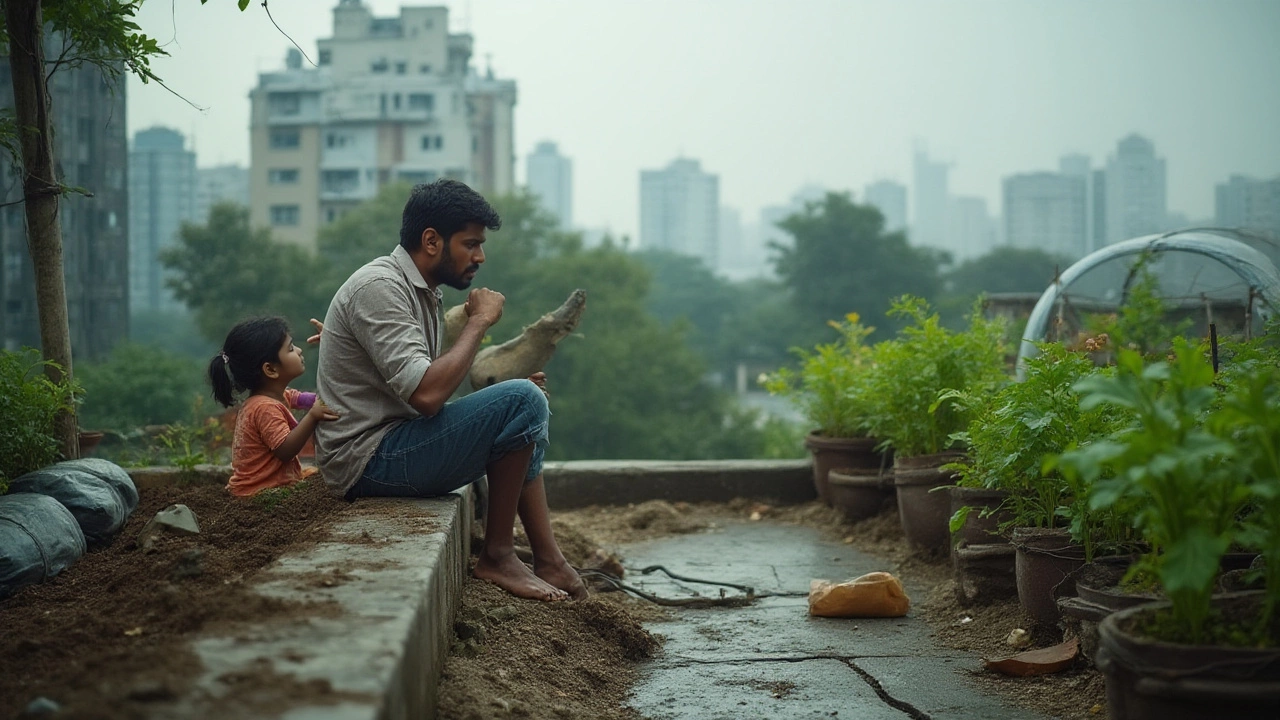Picture this: the sun's shining, bees buzz around your kale, and you've transformed a boring city rooftop into a green oasis. Sounds perfect, right? But here’s the kicker—rooftop farming doesn’t always go as smoothly as those Instagram posts would have you believe. No one talks about the unexpected headaches, the bills, or that time your water tank froze and flooded the neighbour’s flat below in January. For all its buzz, rooftop farming brings a whole crop of hidden problems most folks don’t spot from street level. Let’s be honest—some of these issues go far beyond a couple of wilted basil plants on a Sunday morning.
The Weighty Problem: Structural Risks and Limitations
Ever tried to guess what’s holding up your flat’s roof? Most city roofs were never designed for three tons of wet compost, raised beds, and rainwater catchment barrels. The first serious hurdle is figuring out if your building can even handle the load—structural engineers become your new best mates pretty quickly. And their verdict is rarely cheap. Here’s the reality: soil is heavy. A standard raised bed, filled and watered, can weigh more than a small car. Add to that water tanks, pots, planters, and all those bags of fertilizer you thought you’d need, and the numbers climb faster than a beanstalk on Miracle-Gro.
Most UK homes, and plenty of commercial buildings, just can’t cope with this extra stress. This isn’t just theory—in London, some retrofitted rooftop gardens have started to sag years after installation, leading to expensive fixes or forced removal. In Manchester, the council’s been keen to remind building owners: every kilogram of extra weight increases the risk of leaks, long-term roof damage, and yes—full-on collapses, though that’s mercifully rare.
And none of this gets easier with older structures. Victorian terraces and classic brick facades aren’t famous for modern waterproofing. If you skip the right roof membrane or skimp on drainage, water will slowly work its way into your ceilings. You could be looking at black mould, rotting rafters, and not-so-friendly exchanges with your landlord. Proper structural upgrades and waterproof layers are essential, but they come with eye-watering costs and mess. Even the most enthusiastic urban grower has to weigh up whether all those tomatoes are really worth it.
Another thing: many planning permissions restrict what you can add to your roof, especially in city centres or conservation zones. If you’re not careful, you could find your ‘eco-project’ tangled up in red tape or legal disputes. There’s nothing quite like a council letter to kill your horticultural high. The takeaway? If you have doubts about your roof’s strength, err on the side of caution—not every roof is cut out for farming dreams, and not every risk gives a second chance.
Hidden Costs: It’s Not as Cheap or Simple as It Looks
The dream of free herbs and homegrown courgettes loses a bit of shine once you start totalling up the costs. First up: insurance. Your existing cover probably doesn’t include a vegetable jungle overhead. Some insurers hike up premiums or refuse altogether if you’re messing with the roof. Then there’s the price of structural surveys, materials, and the necessary permits. Even DIY projects often need professional input.
Bags of compost, custom planters, irrigation setups and replacement tools add up fast. Ever heard of geotextile membranes? You will, and your bank account will remember. Waterproofing and reinforcing a mid-sized roof can eat thousands—sometimes more than £10,000 on commercial projects, and rarely less than £2,000 for home jobs if you do it all properly. Skipping steps isn’t really an option unless you want an indoor pond next time it rains. People sometimes talk about grant schemes from local councils, but these are small, fiercely competitive, and rarely cover more than the basics.
Don’t forget ongoing costs. Urban environments throw all sorts of curveballs—insect infestations, hungry birds, or wind damage. Your system will need frequent repairs. If you’re growing food rather than flowers, pests like aphids and cabbage moths don’t care if your broccoli is 100 feet off the ground. Replacement soils, seasonal plantings, fertilizer, and constant pest management—it all adds up. Over time, you may end up spending more on maintaining your rooftop plot than you’d ever pay for veggies down at the supermarket.
And moving heavy loads is a whole different game. Lugging bags of compost or timber up narrow stairwells or squeezing them into ancient lifts isn’t just hard work; it risks damage to the building and annoys your neighbours. Some rooftop farmers in Manchester team up for bulk deliveries, but storage often becomes a nightmare. And as the years go on, roofs shift and patchwork repairs pile up. Cheap at first, but in the long run, your rooftop farm can quietly drain your savings faster than you’d ever expect.

Maintenance Nightmares: Weather Damage, Leaks, and More
Mother Nature doesn’t love a city rooftop any more than she does your back garden. In fact, exposure is roughly ten times worse. Intense sunlight, biting winds, and hard rain batter everything, from flimsy trellises to heavy-duty raised beds. On a typical rainy week in Manchester, excess water can flood containers, leach out nutrients, and swamp delicate seedlings. Worse still, leaks find their way into places you never even knew existed. Even top-dollar waterproof membranes can fail under constant assault from weather, tree roots, or shifting tiles.
If you don’t fancy checking on your plot daily, rooftop farming isn’t for you. Plants need near-constant care—watering, feeding, picking out slugs, adjusting shade, and fighting off disease. Consider something as simple as watering: in summer, containers dry out in half a day. In winter, taps can freeze. Forget it once, and you’re met with dead plants or worse—a burst pipe. Automatic irrigation helps, but it’s not fail-safe. A local grower once watched an irrigation failure flood an entire tomato crop and send a trickle of water into neighbours’ porches several floors below. Cue emergency mopping and awkward apologetic notes.
Then there are the everyday annoyances: pigeons digging up seeds, urban foxes nosing around in compost bags, snails somehow scaling five stories of brickwork. And, since everything is exposed, wind can flatten plants in minutes. Sourcing windbreaks or trellises and making constant repairs is standard for rooftop gardeners. Anyone who promises a low-maintenance Eden probably hasn’t farmed one in the north of England. Add the creeping grime of city pollution—fine dust on leaves, invisible residues in produce. Some studies have detected slightly elevated heavy metals in rooftop-grown crops in central London, making washing and soil choice extra critical if you’re planning to eat what you grow.
If you’re running a shared or rented space, maintaining boundaries becomes a challenge. With each passing season, plans change, people move out, and suddenly nobody’s in charge of the tomato corner or the compost heap. Stuff falls apart. A neglected farm quickly becomes an eyesore, and clearing it is even more hassle than starting fresh. Not exactly the green city future we all imagine.
Legal Roadblocks and Urban Complications
Turns out, you can’t just march up with a bag of seeds and start farming any available rooftop. It starts with permission—most flats or office blocks are owned by management companies or councils who worry about insurance, liability, and aesthetics. They’re not always eager to say yes. And getting formal sign-off is only half the battle: you’ll still need to navigate planning applications, building regulations, and lease restrictions. Plenty of people make innocent mistakes. The outcome? Forced removal or (worse) disputes with neighbours, often leading to legal action. If you’re not comfortable being a part-time lawyer, things can get messy fast.
The noise factor can become a problem, too. Early-morning gardening sessions, the rumble of compost deliveries, or the whine of power tools all carry across rooftops. Not everyone in your building will love your project, especially if it disrupts their morning lie-in. Arguments over who can access the space, or how produce is shared, can sour relationships faster than a slug in your salad.
Safety is another overlooked concern. Rooftop access almost always involves ladders, narrow stairs, or steep drops—none of it ideal for anyone with mobility issues or young kids. Falls, slips, or even simple strains while carrying bags or watering cans are real risks. Some insurance policies flatly exclude injuries sustained “while working” on a non-designated outdoor roof. That’s an expensive accident waiting to happen if you’re not careful.
City pests and pollution round out the raft of problems. Urban air isn’t exactly clean, with airborne metals and diesel residue sticking to leaves and contaminating rain run-off. It’s essential to wash produce thoroughly and consider growing fruiting crops (like tomatoes or courgettes), which tend to absorb less pollution than leafy greens. If wildlife finds your rooftop paradise, you could also end up with rats or birds nesting, leading to new headaches for you—and your neighbours. Every solution creates a new mini-problem. Urban rooftop farming can feel a bit like playing whack-a-mole, but with compost and bureaucracy.
So, for every glossy magazine shot of city rooftop lettuce, there are hidden layers of hassle that go with it. The pay-offs can be real—nothing beats a homegrown salad straight from the skyline—but ignoring the downsides usually leads to disappointment, or worse, expensive mistakes. If you want to make rooftop farming work in the city, you have to go in with your eyes wide open, ready to face the practical, legal, and financial challenges that come up along the way. Clear planning, expert advice, and solid commitment matter a whole lot more than the right hashtags or pretty views.

